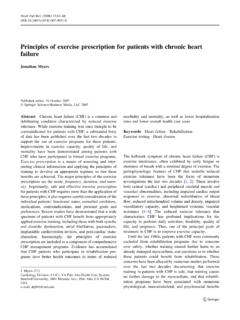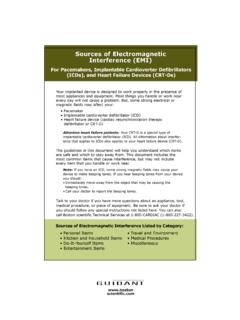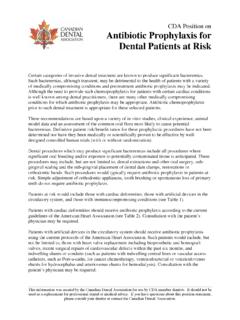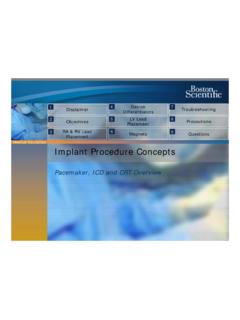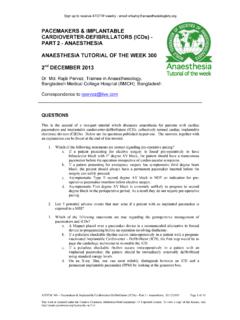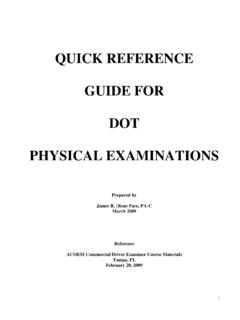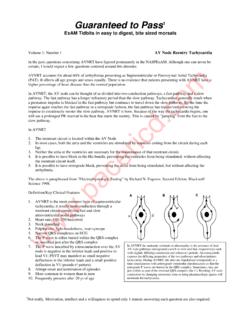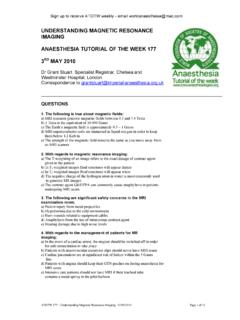Transcription of TemporaryTemporary PacemakersPacemakers - …
1 (c) 2000-2008 David Stultz, MD. Temporary Pacemakers November 14, 2007. David Stultz, MD. Southwest Cardiology, Inc. (c) 2000-2008 David Stultz, MD. Topics to be covered Indications Pacemaker nomenclature Insertion Technique Complications Orientation to the box (Pacemaker). Troubleshooting Questions? (c) 2000-2008 David Stultz, MD. General indications for a temporary pacemaker Heart rate is slow, causing hemodynamic compromise Sick sinus syndrome Sinus bradycardia or atrial fibrillation with slow heart rate response (generally <40 bpm). Heart block 3rd degree 2nd degree type 2 (Mobitz). Malignant Tachyarrhythmia caused by bradycardia Torsades de Pointes (c) 2000-2008 David Stultz, MD.
2 Clinical settings for temporary pacemaker Syncope Myocardial infarction Especially inferior Shock due to bradycardia Myocarditis Lyme disease (c) 2000-2008 David Stultz, MD. 2 nd Degree AV block type 1. Wenkebach not a reason for pacemaker (c) 2000-2008 David Stultz, MD. 2nd Degree AV block type 2. (Mobitz). (c) 2000-2008 David Stultz, MD. Inferior/Lateral/Posterior Infarct with 2:1 block (c) 2000-2008 David Stultz, MD. 3 rd degree heart block (c) 2000-2008 David Stultz, MD. Another 3 rd degree heart block (c) 2000-2008 David Stultz, MD. Atrial fibrillation Asystole (c) 2000-2008 David Stultz, MD. NSR 20 second asystole (c) 2000-2008 David Stultz, MD. Pacemaker Nomenclature common Modes VVI Single chamber (ventricle).
3 DDD Dual chamber AAI (uncommon) Single chamber (atrium). 1st Letter is chamber PACED. 2nd Letter is chamber SENSED. 3rd Letter is response I = Inhibit T = Triggered (Unusual). D = Dual (Inhibit or Pace). 4th Letter R = Rate responsive (permanent pacers). (c) 2000-2008 David Stultz, MD. Components of a pacemaker system Lead Wire connects to heart Percutaneous Ventricular wire sits in RV apex Epicardial (post surgery). (c) 2000-2008 David Stultz, MD. The Can AKA Pulse Generator, Battery . Temporary Permanent single chamber Single chamber Dual chamber al%20 Care/Images%20_l1 (c) 2000-2008 David Stultz, MD. (c) 2000-2008 David Stultz, MD. Sites of insertion for a temporary pacemaker Right internal jugular Left subclavian vein Right subclavian vein Either femoral vein (Fluoroscopy required).
4 Left IJ is possible but very difficult (c) 2000-2008 David Stultz, MD. Seldinger technique for percutaneous vascular access General steps Trendelenberg position or leg elevation can facilitate access to IJ and subclavian veins Sterile Field Anesthetize skin with lidocaine Access vein with Cook needle Insert guidewire Remove needle Consider making a skin nick with scalpel Insert 6-8F introducer sheath with dilator over guidewire Remove dilator and guidewire Flush sheath using side port Advance temporary pacemaker to right ventricle ICU Book (Marino). (c) 2000-2008 David Stultz, MD. Complications of temporary pacemaker insertion Blood loss/hematoma Infection Arrhythmia (especially during insertion).
5 PVC's are common Heart block Especially in patients with underlying LBBB. Bundle branch block Pneumothorax (about 1+% when subclavian access used). Cardiac perforation Tamponade Pneumothorax of Left Lung (c) 2000-2008 David Stultz, MD. (c) 2000-2008 David Stultz, MD. Functions of a pacemaker Sensing The device sees' a native heart beat Pacing The device delivers a shock to stimulate a heart beat (c) 2000-2008 David Stultz, MD. VVI Explained A VVI pacemaker Paces the ventricle Senses the ventricle In response to a sensed event it INHIBITS the pacing response So if it doesn't SENSE a native heart beat in a specified period, it will deliver a pace. (c) 2000-2008 David Stultz, MD.
6 Timing cycles Braunwald, 7th ed. VVI pacemaker LR = lower rate limit VRP = ventricular refractory period Note that a sensed QRS starts the VRP and resets the LR. (c) 2000-2008 David Stultz, MD. The dials on the Temporary pacemaker Rate Determines the lower rate limit of the device Heart rate should not go lower than the set rate Output In milliamps, the amount of juice' the device outputs with each pacer spike (c) 2000-2008 David Stultz, MD. Sensitivity Sensitivity asynchronous In millivolts, the amount of energy that has to be detected in order for the device to sense' a beat Higher millivolts = less sensitive More likely for the pacemaker to pace at the lower rate regardless of what the heart does on its own Lower millivolts = more sensitive More likely to pick up noise, and sense' a ventricular beat even though nothing actually happened (c) 2000-2008 David Stultz, MD.
7 Sensitivity Async 0 mV. Sensitivity low . Everything (QRS, T, U). can be sensed by the pacemaker as a QRS. (c) 2000-2008 David Stultz, MD. Sensitivity Async Sensitivity low 0 mV. QRS and some T waves will be sensed by pacemaker as a QRS. (c) 2000-2008 David Stultz, MD. Sensitivity Async Sensitivity just right QRS will be sensed, T waves will not 0 mV. (c) 2000-2008 David Stultz, MD. Sensitivity Async Sensitivity too high Nothing will be sensed 0 mV. (c) 2000-2008 David Stultz, MD. Testing thresholds Output Threshold Set Sensitivity to asynchronous'. Set Rate just above the native heart rate 60-80 bpm Start output at 5-10 mA, and gradually turn down until ventricular capture is lost The last point before losing capture is the threshold Pacemaker output should be set at 2-3x the threshold (c) 2000-2008 David Stultz, MD.
8 Testing Thresholds Sensitivity Threshold Not always necessary Testing the amplitude of native QRS complexes as seen by the can Set Rate just below native heart rate Set Output at 2-3x the Pacing threshold Start asynchonrous, then slowly turn dial down. Pacemaker spikes will disappear when the sensitivity threshold is reached. The pacemaker can now see' the native QRS. complexes. The pacemaker should be set at a sensitivity 1/3 to 1/2 the sensitivity threshold (c) 2000-2008 David Stultz, MD. Troubleshooting Pacemakers Normal behavior that looks strange Failure to Capture Undersensing Oversensing Cross Talk (Dual Chamber only). (c) 2000-2008 David Stultz, MD. Normal behavior of VVI pacemaker Native QRS.
9 (c) 2000-2008 David Stultz, MD. Normal behavior of VVI pacemaker Paced beat with capture (c) 2000-2008 David Stultz, MD. Normal behavior of VVI pacemaker Fusion beat combination of native QRS and paced beat (c) 2000-2008 David Stultz, MD. Normal behavior of VVI pacemaker Pseudofusion pacing spike, normal QRS. (c) 2000-2008 David Stultz, MD. Failure to Capture Braunwald, 7th ed. Atrial pacing with intermittent ventricular capture (c) 2000-2008 David Stultz, MD. Failure of output (oversensing). Braunwald, 7th ed. VVI pacemaker sensing artifact as ventricular contractions (oversensing). As a result, the pacemaker does not output (c) 2000-2008 David Stultz, MD. Undersensing Braunwald, 7th ed.
10 VVI pacemaker 3rd ventricular beat is a PVC, but it is followed by a pacemaker spike 4th beat is a probably a normal ventricular beat, but it is also followed by a pacer spike (c) 2000-2008 David Stultz, MD. Cross Talk Braunwald, 7th ed. Dual chamber pacemaker in DDD mode 3rd atrial pacing spike is not followed by ventricular spike Ventricular lead detects the atrial spike as a ventricular depolarization, So the pacemaker fails to deliver a ventricular spik
